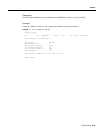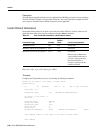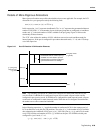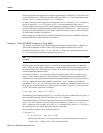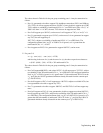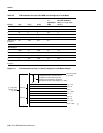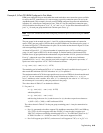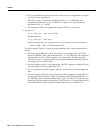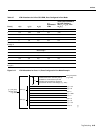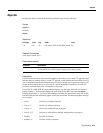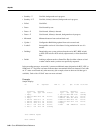
Tag Switching 9-43
cnfrsrc
Example 2, 8-Port OC3 BXM Configured in Port Mode
BXM ports configured for port mode rather than trunk mode have more connection spaces available
for use by the TVC connections as it is not necessary to provide connection spaces for use by the
AutoRoute trunks. This example is for an 8-port OC3 BXM configured for port mode and therefore,
in Release 9.1, with all ports configured as ports. Table 9-7 lists the configured connection space
(LCN) allocations for each port of “a (x)”, “n
1
(x)”, and “ m
1
(x)”. It also shows the unallocated LCN
pool, “z
1
“ for each port group and the total common pool access, “g”.
Note LCN is the variable affected when configuring connection space allocations using the cnfrsrc
command.
The port groups in the example are ports 1-4 and 5-8, and the maximum number of connection
spaces (LCNs) per port group is 8192 for this 8-port-OC3 BXM card. The allocations for ports 1-4
are shown in Figure 9-12. The allocations for ports 5-8 are similar to that shown in Figure 9-12, but
with correspondingly different values.
As shown in Figure 9-12, “g” is the total number of connection spaces (LCNs) available to port
group 1-4 and is equal to 8192 LCNs in this example. To find the number of unallocated LCNs
available for use by port partitions that exhaust their assigned number of LCNs, proceed as follows:
From “g”, subtract the sum of the AutoRoute connections, “a (x)”, and the sum of minimum
guaranteed LCNs, “n
1
(x)”. Also, since the ports in this example are configured in port mode, “t”
equals zero in the expression “t*270”. This is indicated as follows:
The remaining pool of unallocated LCNs is “z
1
” as shown. This pool is available for use by ports 1-4
that exceed their minimum VSI LCN allocations “n1 (x)” for partition 1.
The maximum number of LCNs that a port partition can access on a FIFO basis from the unallocated
pool “z1” for new connections can only bring its total allocation up to either “(z
1
+ n
1
(x) ) or
m
1
(x)”, whichever value is smaller. Also, since “z
1
” is a shared pool, the value of “z
1
” will vary as
the common pool is accessed by other port partitions in the group.
The values shown in Table 9-7 are obtained as follows:
• For ports 1-4:
z
1
= (g - sum ( a(x) ) - sum ( n
1
(x) -0*270)
which simplifies to:
z
1
= (g - sum ( a(x) ) - sum ( n
1
(x) )
and factoring in the sum of a (x) and the sum of n
1
(x), the above expression evaluates to:
= (8192 - (185) - (3100) ) = 4907 unallocated LCNs
The values shown in Table 9-7 for the port group containing ports 1-4 may be summarized as
follows:
— Port 1 is guaranteed to be able to support 120 AutoRoute connections (PVCs) and 3000 tag
VCs (TVCs). It will not support more than 120 PVCs. It may be able to support up to
3500 TVCs, subject to availability of unallocated LCNs “z
1
” on a FIFO basis. Since “m
1
(1)”
of 3500 is less than “z
1
“ of 4907, the most TVCs that can be supported are 3500.
— Port 2 will support up to 50 PVCs, and no more. It will support no TVCs, as “m
1
(2)” = 0.
z
1
= (g - sum ( a (x) ) - sum ( n
1
(x) ) - t*270 )



